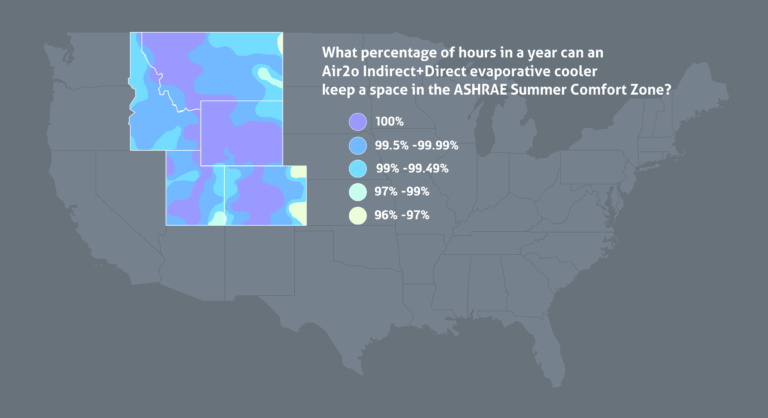Indirect + Direct evaporative cooling (IDEC) is a viable method to keep temperature and humidity within the ASHRAE comfort zone throughout most of the Rocky Mountain region. Air2O, the next generation of air conditioning systems, recommends designing for 100% outside air when applying an IDEC system in most applications.
An hourly analysis of Air2O’s IDEC performance under these conditions shows IDEC’s efficacy. Using hourly weather data in Colorado Springs, Colorado, Air2O’s IDEC unit will provide supply air of 63°F or less for 100% of the year. The results vary based on local weather, but Air2O’s IDEC unit can provide supply air at less than 63°F for 99.5% of the year in nearly all of Colorado, Utah, Idaho, Montana and Wyoming.
Figure 1 below gives a visual overview of the effectiveness of IDEC in these states.

The designer needs to take a slightly different approach to determining the required airflow and sizing the equipment when cooling with 100% outside air. Some applications do require recirculating air for cooling, such as data centers, or green houses, which Air2O can accommodate. When designing with 100% outside air, it can be helpful to work backwards, starting with the space requirements. In this example, we can start with the upper point within the ASHRAE comfort zone as the maximum allowable condition within the space—and these can be achieved with saturated supply air at 63°F. Because we are cooling with 100% outside air, the latent load is being exhausted out of the building and there will not be any latent regain from return air. Using the sensible heat load on the space (skin load, solar load, and internal load), and a 15°F temperature differential, the required airflow can easily be calculated to determine equipment size. Air2O can provide these calculations for specific projects.
These results are accomplished using less than half of the energy of a standard packaged rooftop unit and no refrigerant. The reduced kWh consumption results in a reduced water footprint, despite a small increase in on-site water usage.
Naturally, IDEC will not be suitable in all applications. To bridge the gap, Air2O also manufactures a hybrid IDEC unit that includes packaged DX cooling to trim the supply air during the relatively few hours of the year that IDEC alone may not be able to meet the owner’s needs.
If you would like to have Air2O analyze the use of IDEC on your project, please contact us.
The designer needs to take a slightly different approach to determining the required airflow and sizing the equipment when cooling with 100% outside air. Some applications do require recirculating air for cooling, such as data centers, or green houses, which Air2O can accommodate. When designing with 100% outside air, it can be helpful to work backwards, starting with the space requirements. In this example, we can start with the upper point within the ASHRAE comfort zone as the maximum allowable condition within the space—and these can be achieved with saturated supply air at 63°F. Because we are cooling with 100% outside air, the latent load is being exhausted out of the building and there will not be any latent regain from return air. Using the sensible heat load on the space (skin load, solar load, and internal load), and a 15°F temperature differential, the required airflow can easily be calculated to determine equipment size. Air2O can provide these calculations for specific projects.
These results are accomplished using less than half of the energy of a standard packaged rooftop unit and no refrigerant. The reduced kWh consumption results in a reduced water footprint, despite a small increase in on-site water usage.
Naturally, IDEC will not be suitable in all applications. To bridge the gap, Air2O also manufactures a hybrid IDEC unit that includes packaged DX cooling to trim the supply air during the relatively few hours of the year that IDEC alone may not be able to meet the owner’s needs.
If you would like to have Air2O analyze the use of IDEC on your project, please contact us.

